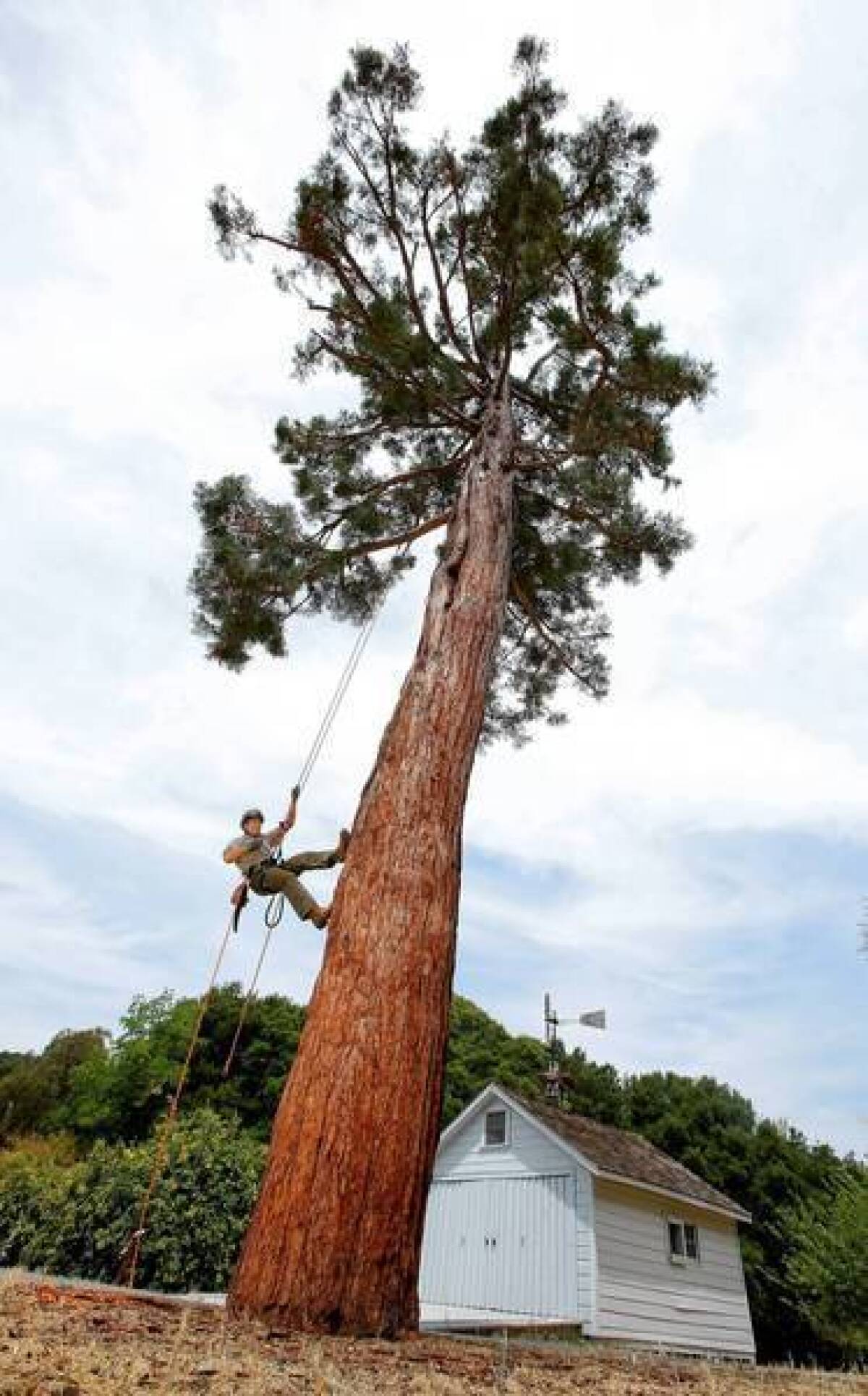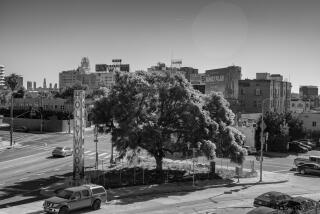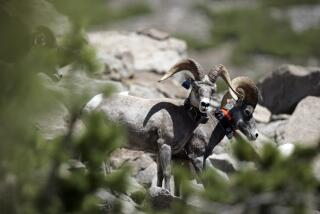Horticulturist is rooting for diseased Muir sequoia

MARTINEZ, Calif. — It would be hard to equal John Muir’s love for the giant sequoia, a majestic California native that can live 3,000 years and soar 250 feet high.
“The King tree & me have sworn eternal love,” he wrote to a friend in the fall of 1870, “sworn it without swearing and Ive taken the sacrament with Douglass Squirrels drank Sequoia wine, Sequoia blood, & with its rosy purple drips I am writing this woody gospel letter.”
A decade or so later, the besotted conservationist returned from a Sierra Nevada jaunt with a seedling wrapped in a damp handkerchief. He planted the slender specimen in a place of honor on his family’s fruit ranch.
Today, Muir’s homestead 35 miles northeast of San Francisco is a national historic site. And the sequoia, 70 feet tall, is dying of an airborne fungus.
Keith Park loves this particular tree almost as much as Muir loved them all — which is why the young National Park Service horticulturist is trying to keep at least a remnant of the ailing conifer alive by cloning it.
Not because it is the tallest tree on the Muir land, or the rarest or the oldest. But because, among the peach orchards and grape vines, Canary palms and olives, it is a “signature tree. John Muir himself had a hand in bringing it from the Sierra,” Park said. “To me, it’s a symbol of him and his love for the mountains, down here in the hot Alhambra Valley.”
Muir was father of the modern conservation movement, a camping buddy of Theodore Roosevelt and founder of the Sierra Club. He once hiked 1,000 miles from Kentucky through Florida and is credited with discovering active glaciers in the Sierra Nevada.
What is less widely known about the man who described himself as “hopelessly and forever a mountaineer” is that he also was a shrewd businessman and successful farmer, a chapter of his life captured at the historic site here.
In 1880, Muir married Louisa “Louie” Strentzel and moved to Martinez, where he helped operate his father-in-law’s fruit ranch. Dr. John Strentzel was a keen horticulturist with an eye for exotic plantings; Muir focused efforts on the ranch’s most profitable crops: Bartlett pears and table grapes.
It was in the second-floor “scribble den” of the homestead’s Italianate mansion, all elegant crown moldings and soaring ceilings, that Muir wrote such classics as “My First Summer in the Sierra” and “The Mountains of California.”
“Going into the house, it doesn’t evoke what Muir was,” said Sue Fritzke, deputy superintendent of the site. “The coolest thing to me is the scribble den, with his desk and his chair, and getting the idea of him sitting there, looking out the windows and writing all of his works.”
Visible out a small west window in the corner is the cinnamon red bark of the beautiful but troubled Sequoiadendron giganteum.
It has been there since the mid-1880s. A black-and-white photograph shows a stern Strentzel posed stiffly beside an incense cedar. To the left is a small crate on a triangular patch of dirt. The crate protects the young and tender sequoia from mishap.
Today, the tree towers above the ranch’s carriage house, mighty at first glance in the bright summer sunshine.
“See that large scar?” Park said, looking closer and pointing to a canker on its trunk. The gash begins a dozen feet above the ground and continues up another 10 feet, to the edge of the branches. “I’m guessing it’s a sign of the fungus.”
Interspersed among the deep green foliage are sprays of dead, brown needles. Every year Park rents a boom lift to take him into the sequoia’s canopy, from which he trims away the dead boughs. With each cut, he must sterilize his tools with a blowtorch to keep the fungus from spreading.
“I try to do everything I can to keep the disease controlled,” Park said. “It’s a dynamic process of new growth versus dead material. As long as the tree puts out more new stuff than is dying, it’s OK.”
The problem, said William Libby, professor emeritus of genetics and forestry at UC Berkeley, is that sequoias do best at elevations above 2,500 feet. Anything lower than that stresses the trees, and they become weakened and susceptible to disease.
Muir “loved these trees at the expense of his family,” Libby said. “What John Muir could not have possibly known at that time was that a giant sequoia would get a disfiguring and usually lethal disease if it’s planted near sea level.”
The goal at the John Muir National Historic Site is to preserve the landscape in such condition that if the naturalist came back, he would recognize it as home. That means creating a genetic replica of the tree Muir planted.
And that means cloning, a tricky proposition even with relatively young sequoias.
“We’ve cloned thousands of them in the 1- to 2-year-old class and never missed,” said Libby, who is on the research committee of the Save the Redwoods League. “When you get to 6, you get some that don’t work. By the time they’re 20, most don’t work. We’ve never [cloned] one beyond 80.”
Park tried cloning Muir’s 130-year-old sequoia shortly after he came to the historic site, to no avail. Then earlier this year he read about a Michigan-based nonprofit called Archangel Ancient Tree Archive, which has successfully cloned trees planted by George Washington at Mount Vernon and a beech planted by Roosevelt at Sagamore Hill in New York.
So Park climbed back into the tree’s canopy, trimmed two dozen cuttings from healthy young branches, popped them into a Ziploc bag and shipped them off.
Jake Milarch, an archive propagator, snipped the cuttings into 400 smaller pieces, treated them with rooting hormone and established them in a growing medium. Three months have passed, and 397 are still alive. David Milarch, Jake’s father and the organization’s co-founder, said he was “about 90% sure” the cloning process would work.
The cuttings are expected to begin rooting by December or so and, if all goes well, be ready for replanting in another year. The big question, however, is where.
The Martinez spread is Muir’s home, but it’s not healthy for the mighty sequoia. The Sierra Nevada is a perfect spot, but it’s not Muir’s home.
Either way, Park acknowledged, it’s a good problem to have because it means that Muir’s legacy will live on.
Somewhere.
More to Read
Start your day right
Sign up for Essential California for news, features and recommendations from the L.A. Times and beyond in your inbox six days a week.
You may occasionally receive promotional content from the Los Angeles Times.







